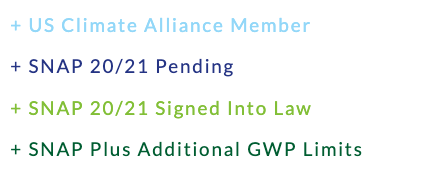MILL VALLEY, Calif.—The North American Sustainable Refrigeration Council (NASRC), a 501(c)(3) environmental nonprofit working to advance climate-friendly natural refrigerants in supermarkets, announces its newest Gold-level member, Lowe Corporation. A collective of 5 pioneering brands comprised of Lowe Rental, LoweConex, Abbey Design Associates (ADA), Portal Kitchens Limited (PKL) and Rental+ who together are committed to delivering sustainable rental services.
Lowe Rental's unique offering, RaaS (Refrigeration as a Service), provides self-contained propane (R290) refrigeration cases. These act as temporary solutions for retailers transitioning to natural refrigerants, minimizing store disruptions and maintaining customer experiences.
“Our retail services enabled one of the world’s largest retailers to convert stores across the USA to CO2 refrigeration by 2040 without the closure of store locations or disruption to customer sales. Allowing their organization to meet legislated requirements while maintaining 97% of store revenue,” said Kyle Payne, Head of Retail Sales USA for Lowe Rental.
This is an important solution amidst the phase-out of commonly used hydrofluorocarbon refrigerants (HFCs), which are extremely potent greenhouse gases and one of the leading drivers of climate change. Natural refrigerants like CO2, ammonia, and propane have near-zero global warming potential, making them climate-friendly and future-proof natural alternatives to HFCs.
Transitioning to these alternatives, however, requires a costly full system replacement. Stand-alone R290 cases like those available through Lowe Rental offer a flexible solution that enables a gradual transition and reduces store down time. Lowe Rental’s retail services offering is also supported by refrigeration design consultants, Abbey Design Associates, and LoweConex, an asset control technology to monitor refrigerants and detect leaks. This combination provides a holistic solution to support refrigeration infrastructure upgrades.
“As a trusted partner to multi-national retailers across the USA and around the world, we have seen a dynamic shift towards natural refrigerants and energy efficient refrigeration that enables retailers to minimize their environmental impact,” said Richard Epton, Chief Operating Officer USA for Lowe Rental. “It was imperative we partnered with NASRC to play a vital role in addressing barriers to adoption head on, participating in collective discussion to accelerate meaningful action within the retail industry.
By working with stakeholders from virtually every sector of the grocery refrigeration industry, NASRC is leading efforts to accelerate the transition to natural refrigerants. Its membership network represents over 51,000 US food retail locations as well as service contractors, manufacturers and suppliers, consultants, engineering firms, utilities, trade associations, nonprofits, and schools.
“Lowe Corporation’s investment in an NASRC membership demonstrates a strong commitment to advancing natural refrigerants,” said Danielle Wright, NASRC Executive Director. “We’re thrilled to welcome them to our network and look forward to collaborating with them to drive solutions for the industry and the climate.”
About the North American Sustainable Refrigeration Council
The North American Sustainable Refrigeration Council (NASRC) is a 501(c)(3) environmental nonprofit working to advance climate-friendly natural refrigerants and reduce greenhouse gas emissions caused by traditional HFC refrigerants. We collaborate with stakeholders from across the industry, including over 51,000 food retail locations, to eliminate the barriers to natural refrigerants in supermarkets. For more information, visit nasrc.org, LinkedIn, Twitter and YouTube.
About Lowe Corporation
Established 1977 in Northern Ireland, Lowe Corporation has continued to lead and innovate rental solutions for refrigeration and foodservice equipment around the world. Today under five owned brands and operating from eighteen locations throughout UK, USA, Asia and Europe, Lowe brings together an award-winning suite of equipment rental solutions, industry redefining IoT technology and recognised global refrigeration expertise that empowers its customers to achieve their financial and environmental goals. For more information visit www.lowerental.com, www.abbeydesignassociates.com, www.loweconex.com.












